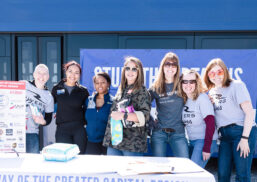The New Economy of Amateur Athletics
In August 1852, the Yale and Harvard rowing teams competed in a two-mile race on Lake Winnipesaukee in New Hampshire. Harvard won the inaugural race, going on to a 95-58 overall record since. This event is more commonly referred to as the Harvard-Yale Regatta, now held on the Thomas River in New London, CT. In addition to beginning an annual ritual between the two Ivy League schools, this was history’s first intercollegiate sporting event. Since the initial contest over 170-years ago, amateur athletics have undergone many significant developments – the first intercollegiate baseball game was played between Williams College and Amherst College in 1859; the National Collegiate Athletic Association (NCAA) was founded in 1906; and the current three division system was adopted in 1973. Quite possibly the biggest and most controversial change occurred in 2021, when the Supreme Court decided that student-athletes may earn compensation for their name, image, and likeness (NIL).
The NCAA has long been under scrutiny for their definition of amateurism and not allowing student-athletes to accept compensation, even going as far as rescinding Heisman Trophies and other awards when players infringed on rules compromising their amateur status. It was not an easy road getting to this point and we could easily get derailed discussing that journey. For that reason, our focus here is on the monetary benefits of NIL deals.
What is a NIL deal and why does it matter?
In its simplest terms, NIL deals allow student-athletes to accept compensation for marketing and promotional endeavors. The NCAA, the schools, and boosters are not paying athletes for their enrollment or competing on their teams. Rather, wages are earned through autograph signings, social media posts, product endorsements, and other branding opportunities. Current rules surrounding NIL deals are vague until Congress drafts national laws providing clearer regulations. In the meantime, states are developing their own rules to govern high school and college athletes1
Whether you are athlete/influencer/entertainer in the position to capitalize on this ruling or the parent of someone who is… there are several considerations to be made.
Who is benefiting from NIL Deals?
When someone says NCAA, many immediately think of March Madness or the College Football National Championship. While each division crowns their own champions, Division I athletes typically have the biggest platforms and largest followings, thus the most lucrative NIL deals.
The 2023 NCAA Division I Women’s National Championship was the most watched women’s college basketball game of all time. An average of 9.9-million viewers tuned in to see Angel Reese’s LSU team defeat the national sensation, Caitlin Clark, and the rest of her Iowa squad2. That game had higher ratings than any ESPN broadcasted NBA game through the 2022-23 regular season. What a moment for women’s sports. The anchor athletes, Reese and Clark, are cashing in through NIL deals.
As of May 2023, Clark’s NIL valuation totaled roughly $796k annually3 , in comparison to Reese, whose 4-million-plus social media followers earn her close to $1.4 million annually4. Topping the NIL list is recent USC commit and son of NBA superstar, LeBron James, LeBron Raymone “Bronny” James Jr. The soon to be 19-year-old and incoming freshman has an astounding 12.9 million social media followers, leading to as much as $6.8 million per year in NIL deals5. This amount more than triples University of Texas’s incoming freshman quarterback and nephew of NFL legends Peyton and Eli Manning, Archie Manning, who sits at number two on the list of male athletes with $2.8 million in estimated annual NIL deals6.
An interesting note – across all NCAA divisions, women account for almost 40% of NIL activities. Backing out Division I men’s football & basketball, female athletes outpace men in the total number of NIL deals. The highest NIL value among female athletes, and number two among all athletes, is LSU’s Olivia “Livvy” Dunne. The gymnast’s deals are valued at approximately $3.4 million per year7.
The deals mentioned above are some of the highest NIL has to offer. Deals of this size are rare and not a reality for most athletes. That is not to say Division I walk-ons, Division II, Division III, and/or high school athletes cannot profit from NIL opportunities. More than 330,000 of the almost 520,000 collegiate athletes are competing in Division II or III8. Many of whom are monetizing their NIL.
Take Amherst College’s Jack Betts as an example. Amherst is a Division III liberal arts school in Western Massachusetts with a total undergraduate enrollment of 1,9719. Jack, a wide receiver on the football team, has been nicknamed the “King of Division III NIL”. His reported deals are as much as $9,50010. The first came as a brand ambassador, earning him $50 in sales and $75 in merchandise11. As of December 2022, he has secured another thirty-four deals. Jack Betts may not be earning as much as Bronny James or Angel Reese, but it is an impressive feat for a Division III athlete with less than 5,600 Instagram followers.
Where can I find a NIL deal?
For athletes, like Jack Betts, who are not fortunate enough to display their skill in front of a national audience or have, arguably, the best NBA player of all time as a father, there are other resources. Websites like Opendorse, 98strong, and Athletepreneur create a marketplace where athletes can build and monetize their NIL value. Those looking to hire an athlete for a social media post, shoutouts, appearances, etc. can search for young athletes interested in growing their NIL brand. Business of College Sports provides a list of NIL marketplaces – Tracker: NIL Marketplaces for Student Athletes – Business of College Sports.
NIL deals have become an economy of their own. Not only are high school and college athletes now able to accept fair compensation, but these deals are impacting recruiting and transfer portal decisions. What has turned into a competitive market ultimately affects the talent schools are rolling out onto the playing field. In Angel Reese’s and Caitlin Clark’s cases, it has led to growing brands and higher paying NIL Deals. The more traditional Division III athlete, like Jack Betts, may rely on networking and third-party marketplaces to make the most of their NIL opportunities.
You have a NIL deal. What now?
First off, well done! The hard work is paying off, literally. Where do you go from here?
Recognize that you are more than an athlete. Your name, image, and likeness have become your business. Protecting your business is critical to maximize your earning potential. How you conduct yourself will have a direct impact on your NIL success. Often no amount of talent can make up for a person with a questionable character or reputation.
You may consider building a team of trusted professionals around you. This team could include an attorney, an agent, a manager, and a financial planner. With financial benefits being the main premise of NIL deals, financial planners frequently become the “quarterback” of your team, passing the ball to other professionals where necessary.
Much like a typical 9-to-5, income from NIL deals have the potential to trigger tax consequences. Unlike a regular Monday through Friday gig, athletes and entertainers often find themselves working in many states, while possibly living in a separate state. This means they may need to source a portion of their earnings to a series of state taxing authorities. It is common for professional athletes to file tax returns in multiple states, depending on where they live and where the income is earned. NIL athletes are considered more entertainers than athletes but may still be subject to nonresident taxes. Tax circumstances are relevant to each individual’s circumstances and their income but the important piece to understand is that your tax situation is likely more complicated due to NIL income.
Specific tax considerations that may be relevant for NIL athletes:
- Understand your taxable income (e.g., cash, checks, Venmo/PayPal, direct deposits, merchandise, gift cards, cryptocurrencies, Non-Fungible Tokens (NFTs), investment income, etc.)
- Have a system to track income & expenses related to your NIL business. Expenses could include flights, hotels, car mileage, software, equipment, accounting & legal fees, retirement contributions, etc. These costs may be used as a deduction against your income. It is important to keep business expenses and personal expenses separate.
- If your NIL deal is an independent contract, you may receive a 1099 and file a Schedule-C with your tax return. You could also be subject to self-employment tax.
- Making estimated tax payments can help avoid penalties. To avoid federal underpayment penalties, you must pay 90% of your expected tax liability for this year or pay 100% of last year’s tax liability (110% if your adjusted gross income for last year exceeded $150,000). Some states, including New York, conform to this rule but others have their own underpayment penalty rules. Since the 1099 income is not wages, there would not be any withholding (federal or state) so you would be responsible for calculating estimated tax payments.
- Parents may no longer be able to claim their child-athlete as a dependent.
- Student-athletes may forfeit their financial aid and potentially lose education tax credits.
- Consulting with a tax professional as early in the process as possible is a good idea.
Life after your NIL career
It is important to recognize the mortality of your athletic career and as a result, quite possibly your NIL income. Even the greatest athletes’ careers come to an end. There is an extensive list of professionals who did not manage their finances well and have found themselves bankrupt when the checks stopped. Your NIL earnings can go faster and more unexpectedly than they came. While the money is coming in, consider setting a percentage aside for your future as a part of your plan to position yourself for success in the long run.
Depending on how your NIL business is organized, a brokerage account, Traditional IRA, SEP IRA, and/or Roth IRA could be appropriate savings/investment vehicles. In expanding your financial prowess to investing, be aware of your strengths and weaknesses. Like an athlete training to develop their craft, understanding and executing on the intricacies of a well-run investment strategy takes years of education and experience. Hiring a financial professional who can help you to navigate this landscape may improve your outlook.
Ask for help.
This is the New Economy of Amateur Athletics. The business of sports has evolved since August 1852, when Yale challenged Harvard to a rowing competition. It is more complex than ever, with more changes on the way. For parents and athletes becoming familiar with NIL, there are many resources available – possibly none better than the team of trusted professionals.
Taxes, investing, and planning are rarely simple, especially in the new wild west of NIL deals. A team of professionals may save you time, money, and headaches. Be wary though, there may be no shortage of wolves in sheep’s clothing willing to lend a not-so-helping hand. Sometimes this can be who you least expect. Work with individuals who have an obligation to act in your best interest, bringing experience and valued guidance to your relationship, and offering transparency in how they are paid.
While NIL deals are a recent development, the strategies used are everyday business to financial professionals. If you or someone you know has NIL opportunities, do not hesitate to reach out to your Atlas team. We are well equipped to discuss options with you.
Individuals who hold the SE-AWMA™ designation have completed a course of study encompassing qualitative planning, trusts, investments, cash flow, budgeting, tax planning, business planning, estate planning, employee and retirement benefits for high-net-worth sports and entertainment clients. Additionally, individuals must pass an end-of-course examination that tests their ability to synthesize complex concepts and apply theoretical concepts to real-life situations.12

Footnotes and Sources
[1] NIL College Rules (on3.com) https://www.on3.com/nil/laws/college/
[2] ESPN Platforms Set Unparalleled Records with NCAA Division I Women’s Basketball – ESPN Press Room U.S. https://espnpressroom.com/us/press-releases/2023/04/espn-platforms-set-unparalleled-records-with-ncaa-division-i-womens-basketball/
[3] Caitlin Clark – Iowa Hawkeyes – CG (on3.com) https://www.on3.com/db/caitlin-clark-162402
[4] Angel Reese – LSU Tigers – SF (on3.com) https://www.on3.com/db/angel-reese-174581/
[5] Bronny James – NIL Profile (on3.com) https://www.on3.com/db/bronny-james-144220/nil/
[6] Arch Manning – NIL Profile (on3.com) https://www.on3.com/db/arch-manning-7353/nil/
[7] Livvy Dunne – LSU Tigers – All (on3.com) https://www.on3.com/db/livvy-dunne-162353/
[8] NCAA_RecruitingFactSheet.pdf (ncaaorg.s3.amazonaws.com) https://ncaaorg.s3.amazonaws.com/compliance/recruiting/NCAA_RecruitingFactSheet.pdf
[9] Amherst College – Profile, Rankings and Data | US News Best Colleges https://www.usnews.com/best-colleges/amherst-college-2115
[10] He’s the Biggest Deal in Division III | December | Amherst College https://acalert.amherst.edu/news/news_releases/2022/december/he-s-the-biggest-deal-in-division-iii
[11] Jack Betts ’24E: The King of Division III NIL (amherststudent.com) https://www.amherststudent.com/article/jack-betts-24e-the-king-of-division-iii-nil/
[12] Sports & Entertainment Accredited Wealth Management Advisor™ or SE-AWMA™ Professional Designation – Credly https://www.credly.com/badges/932af4cf-fb0f-4e9e-8884-0dd5c08d6200




